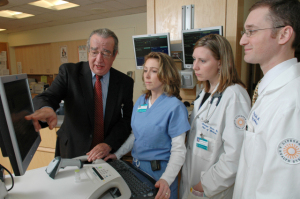by
Joan Trombetti, Writer | March 25, 2009

Reid Coleman, MD, FACP (left)
trains staff on the
Patient Links system at
Rhode Island Hospital
in Providence, RI.
This report originally appeared in the March 2009 issue of DOTmed Business News
It has taken a long time for health care providers to embrace Electronic Medical Records (EMRs) and Electronic Healthcare Records (EHRs) as a way of handling business. As it stands now, according to 2,000 doctors surveyed by NCHS (National Center for Health Statistics), only 4% said their EMR systems were totally functional. It looks like most of the physicians in the U.S. still rely on paper records.
However, with the financial incentive of the economic stimulus promise of $20 billion ($2 billion in grants and loans to install HIT (Health Information Technology) and $18 billion in payment incentives through Medicaid and Medicare, that could change. According to a Congressional Budget Office analysis, 90% of physicians and 70% of hospitals will be using electronic health records within a decade.
Thr Miriam Hospital,
a LifeSpan partner
This, coupled with the 2005 findings by RAND Corporation, which state if EHRs are widely adopted the health care system could save more than $81 billion annually and improve the quality of care at the same time, makes the transition seem likely and well worth it.
Policy makers and health care workers are counting on the RAND study - barring some of the obstacles that seem to plague the HIT world.
When people hear the phrases electronic medical record as opposed to electronic health record they may think there is no difference. While EMR and EHR do share a goal of improving patient safety, quality and efficiency of patient care and reducing health care delivery costs, EMR and EHR are two separate tools that rely on each other to reach their full potential.
NAHIT (National Alliance for Health Information Technology (NAHIT) has established definitions for electronic medical records EMR and EHR.
EMR is the electronic, legal record of health-related information on an individual that is created, gathered, managed and consulted by licensed clinicians and staff from a single organization (hospital, clinic or other ambulatory environment) involved in the individual's health and care. It is composed of clinical data repository, clinical decision support, controlled medical vocabulary, order entry, computerized provider order entry, pharmacy and clinical documentation applications. It supports the patient's electronic medical record across inpatient and outpatient environments and is used by health care practitioners to document, monitor and manage health care delivery within a care delivery organization (CDO). EMR data is the legal record of what happened to a patient during a visit or stay at a CDO. It is owned by the CDO.
EMRs are the data source for EHRs. Patients and consumers, health care providers, employers, payers/insurers and the government are what EMRs are composed of.
